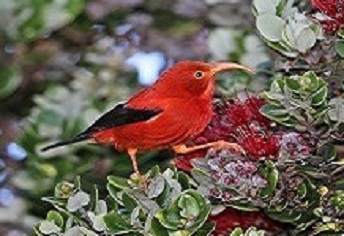Last updated: March 9, 2018
Lesson Plan
Haleakalā Adaptations

- Grade Level:
- Upper Elementary: Third Grade through Fifth Grade
- Subject:
- Science
- Lesson Duration:
- 60 Minutes
- State Standards:
- Hawai‘i Content and Performance Standards III:
SC.3.3.1, SC.3.4.1, SC.3.5.1, SC.3.7.4 - Additional Standards:
- Next Generation Science Standards:
3-LS3-2, 3-LS4-2, 3-LS4-4
Objective
At the end of this lesson, the students will be able to:
1. Describe how plants and animals use adaptations to survive in particular environment.
2. Explain how impacts on a habitat can influence the adaptations of a species.
Background
This lesson is designed to assess the understanding of species adaptations after their field trip to Haleakalā National Park. It is based upon the experiences and lessons completed at the park. It is also meant to illustrate the idea that within nature, everything is interconnected and that disruptions to the ecosystem can have drastic effects on plants and animals. If the effects of pollution, loss of native habitat, or natural disruptions (e.g. volcanic eruption, hurricane, flood, or fire) are too drastic it may even cause a species to become extinct. If it is not so drastic, the species may be able to adapt to the change and survive.
Preparation
Review lessons learned from field trip to park.
Lesson Hook/Preview
Students discuss how species adapt.
Procedure
Step 1: Reflection on Haleakalā Field Trip
Have students write in their journals about what they learned during their field trip to Haleakalā National Park:
- What are the two most interesting things you learned on your trip to Haleakalā National Park?
- Explain two survival adaptations of a plant or animal that lives in Haleakalā National Park.
- Why do you think the plants and animals of Haleakalā National Park had to change or adapt?
- Does Haleakalā National Park do a good job in protecting Maui’s endemic species? Please explain your answer.
Step 2: Students make “Haleakalā Adaptions” Posters
Their poster should include:
- A drawing of a native plant or animal that they learned about on their field trip to Haleakalā National Park.
- The name of that plant or animal.
- A list of the adaptations that help it to survive in Haleakalā National Park.
- Examples of animal adaptations: camouflage, color, beak shape.
- Examples of plant adaptations: leaf shape, hairs, size of plant.
Step 3: Group Presentations of Posters
Students should take turns presenting their posters by describing their species of choice and its adaptations.
Step 4: Impacts on Ecosystems
Once the presentations are finished, follow up with a discussion about the both negative and positive impacts on plant and animal habitats.
- What are the consequences of litter, pollution, habitat loss, droughts, or wildfire?
- What new adaptations might the animals need to survive in the future?
- Discuss some solutions to these negative impacts.
- How does Haleakalā National Park help?
- What can you do to protect habitats where you live?
Vocabulary
Adaptation: A change of form or behavior that helps a species survive in a specific environment.
Camouflage: Coloration or patterns that allow animals to blend into their surroundings.
Ecosystem: A complex set of relationships among the living resources, habitats, and residents of an area.
Extinct: No longer in existence: having died out or ceased to exist.
Pollution: Undesirable state of the natural environment being contaminated with harmful substances as a consequence of human activities.
Survival: Meets the needs of food, water, shelter and space.
Trait: A distinguishing characteristic or quality that makes one organism different from another.
